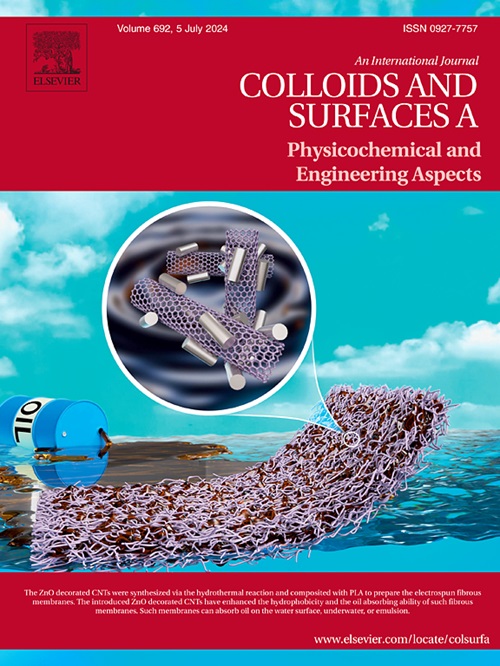Anti-adhesive and antimicrobial coatings on ultrafiltration membranes via dopamine-assisted co-deposition of zwitterionic-cationic copolymers
IF 5.4
2区 化学
Q2 CHEMISTRY, PHYSICAL
Colloids and Surfaces A: Physicochemical and Engineering Aspects
Pub Date : 2025-07-17
DOI:10.1016/j.colsurfa.2025.137774
引用次数: 0
Abstract
To overcome persistent challenges in membrane biofouling mitigation, we engineered a dual-functional zwitterionic-cationic copolymer architecture and proposed a dopamine-assisted co-deposition strategy for surface modification of polyvinylidene fluoride (PVDF) ultrafiltration membranes, optimizing the surface density of zwitterionic/cationic functional groups. The zwitterionic-cationic copolymers were strategically synthesized via activators regenerated by electron transfer for atom transfer radical polymerization, enabling the synergistic integration of strong hydration capacity and potent bactericidal activity. Key influence factors such as functional unit composition, deposition density, and copolymer chain length on the formation of hydration layers and the hydrophilicity of modified membranes were systematically studied. The PDA/p(DCD)-1-PVDF membrane exhibited substantially enhanced performance versus unmodified counterparts: elevated filtration efficiency (187.4 L·m⁻²·h⁻¹ water flux vs. 175.1 L·m⁻²·h⁻¹ with matching bovine serum albumin rejection), superior antifouling performance (84.78 % corrected total flux recovery ratio vs. 43.12 %), and complete bactericidal efficacy (100% eradication of Escherichia coli and Staphylococcus aureus vs. negligible activity). The dual-defense mechanism relies on zwitterionic groups forming hydration layers to prevent protein adsorption, while cationic groups disrupt bacterial biofilms via electrostatic interactions. This work highlights the potential of zwitterionic-cationic copolymer architectures for enhancing the anti-adhesive and antimicrobial properties of ultrafiltration membranes in a variety of applications.
通过多巴胺辅助两性离子-阳离子共聚物共沉积在超滤膜上的抗粘附和抗菌涂层
为了克服膜生物污染的持续挑战,我们设计了一种双功能两性离子-阳离子共聚物结构,并提出了一种多巴胺辅助的共沉积策略,用于聚偏氟乙烯(PVDF)超滤膜的表面改性,优化两性离子/阳离子官能团的表面密度。通过电子转移再生活化剂进行原子转移自由基聚合,战略性地合成了两性离子-阳离子共聚物,实现了强水合能力和强杀菌活性的协同整合。系统研究了功能单元组成、沉积密度、共聚物链长等关键因素对改性膜水化层形成及亲水性的影响。与未经修饰的膜相比,PDA/p(DCD)-1-PVDF膜表现出显著增强的性能:过滤效率提高(187.4 L·m⁻²·h毒血症对175.1 L·m·m⁻²·h毒血症),抗污性能更好(84.78 %校正总通量回收率对43.12 %),完全杀菌效果(100%根除大肠杆菌和金黄色葡萄球菌对微不足道的活性)。双重防御机制依赖于两性离子基形成水合层来阻止蛋白质吸附,而阳离子基通过静电相互作用破坏细菌生物膜。这项工作强调了两性离子-阳离子共聚物结构在各种应用中增强超滤膜的抗粘接和抗菌性能的潜力。
本文章由计算机程序翻译,如有差异,请以英文原文为准。
求助全文
约1分钟内获得全文
求助全文
来源期刊
CiteScore
8.70
自引率
9.60%
发文量
2421
审稿时长
56 days
期刊介绍:
Colloids and Surfaces A: Physicochemical and Engineering Aspects is an international journal devoted to the science underlying applications of colloids and interfacial phenomena.
The journal aims at publishing high quality research papers featuring new materials or new insights into the role of colloid and interface science in (for example) food, energy, minerals processing, pharmaceuticals or the environment.

 求助内容:
求助内容: 应助结果提醒方式:
应助结果提醒方式:


